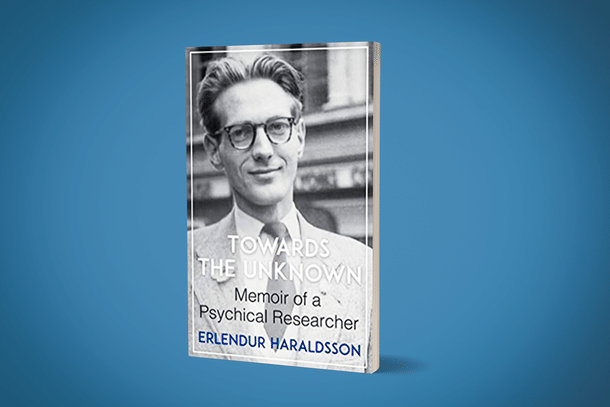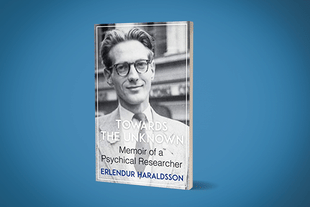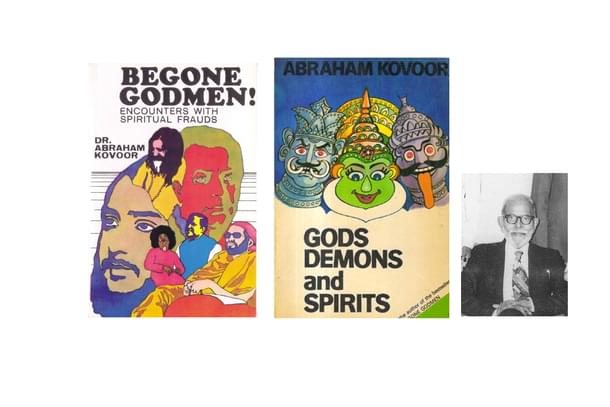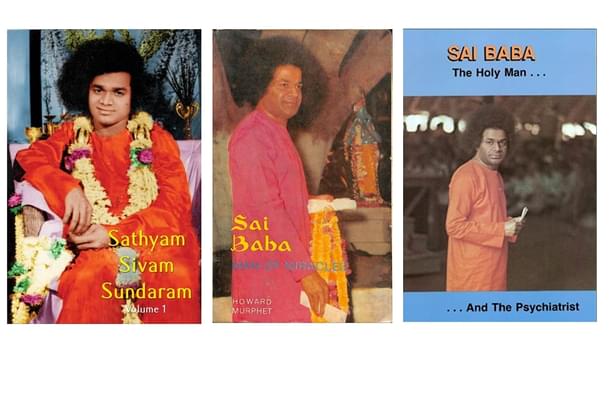Books
Erlendur Haraldsson: A Life Of Studying The Unexplained
Aravindan Neelakandan
Feb 11, 2022, 08:37 PM | Updated 08:37 PM IST
Save & read from anywhere!
Bookmark stories for easy access on any device or the Swarajya app.


In 2020, I was dealing with the sudden loss of my parents. So it was only after a year that I noticed that the famous parapsychology researcher and professor of psychology at the University of Iceland Dr. Erlendur Haraldsson had died on November 2020.
It was sad but not surprising to see that his death had, as far as I could search and find, gone almost unnoticed in Indian media. Haraldsson had done a great deal of work in India, investigating the claims of miracles of Sri Sathya Sai Baba (1926 – 2011) and also in Sri Lanka, where he investigated the claims of children remembering their past lives.
Posthumously, his autobiography ‘Towards the Unknown: Memoir of a Psychical Researcher’ has been published.
His works have a kind of intimate personal dimension for me. My father was a staunch Sri Satya Sai Baba (SSSB) devotee. Bal Vikas, the children’s classes of Sai organization, was used as kind of an antidote to my strong love for the RSS shakhas. To add to the tension, it was exactly at the time that I was going to the shakha that I had also got cured of the notions of a theistic deity.
During the dining table debates, one topic that always led to heated discussion was the ‘miracles’ of Baba.
On my fifteenth birthday, my father, who till his death was a strong Baba devotee, gifted me two books by Dr. Abraham Kovoor, the ace miracle-buster of Sri Lanka, Begone Godmen and Gods, Demons and Spirits, adding that they would help me argue my case against miracles better.
Studying these books also created in me a strong interest in the paranormal, with a healthy overdose of skepticism. Inevitably I arrived at Prof. Haraldsson.

Having gone through the multi-volume biography of SSSB written by Prof. N. Kasturi and other devotional Baba literature including The Man of Miracles (Howard Murphet) and Sai Baba the Holy Man and Psychiatrist (Samuel Sandweiss) I knew almost all the ‘miracles’ of Baba by heart.
Among them was one ‘resurrection from the death’ of a Californian Baba devotee, Walter Cowan. He, with his wife, had come to India to attend the 8th All India Sai organizations Seva conference. Allegedly, he had died on Christmas night of 1971 in Chennai. He was declared dead by the medical authorities but Sai Baba resurrected him – bringing him back from death.

About this incident Prof. Kasturi writes:
Baba has come to assign death its legitimate place in the scheme of existence, neither more nor less. He brought Walter Cowan back from the region beyond death because, as He said, "he has not completed the work he has to do." Baba does not will the effacement of death.
Further testimony for the resurrection came from the wife of Walter, Elsie Cowan herself. If true then this is indeed miracle of the highest kind recorded in modern history.

Haraldsson studied the Baba phenomenon in the 1970s and published in 1987 the results of his investigations Miracles Are My Visiting Cards.
Later in 1997 it was republished as Modern Miracles: An Investigative Report On Psychic Phenomena Associated With Sathya Sai Baba.
In a systematic manner, visiting every medical professional as well as hospital authorities associated with the medical crisis that Cowan underwent on 1971 Christmas night, Haraldsson proves beyond doubt that Cowan had not died on that night.
Dr. O.G.C.Vaz, a general practitioner in Madras and house doctor for Connemara Hotel ... had treated (Cowan) for about two weeks six or seven years before my first interview with him in 1977. .... He had brought in a consultant, Dr. Rajagopalam a cardiologist. Walter Cowan had been seriously ill, Dr. Vaz reported but it was not true that he had died. He was hospitalized for two weeks with high fever and other symptoms, but all the life signs were always present. ...
According to the records of Lady Willington's Nursing Home, Mr Cowan was admitted on December 25, 1971, and discharged on the 15th of January 1972. The head nurse on duty when I visited the hospital told me that she remembered Mr Cowan quite well; he was a particularly pleasant and friendly patient. She also denied any knowledge of his having died or having died or having been almost dead. Dr. Krishna Rao, the superintendent of Lady Willingdon's Nursing Home, checked the medical records for me; Walter Cowan had been alive when admitted into the hospital. ... Dr. Krishna Rao also affirmed with the two other physicians that Cowan had not died while in the hospital.Modern Miracles: an investigative report on psychic phenomena associated with Satya Sai Baba, 1997, pp.251-2
Baba himself had, in a nuanced way, denied the physical reality of Cowan’s death. According to Prof. Sandweiss, Baba said the following about the 'resurrection' experience of Cowan:
The experience was a real experience, not an illusion. It was an experience occurring within Mr. Cowan's mind, and I myself was there— directing and clarifying the thoughts.
What is to be noticed here is the objective and thorough way in which Haraldsson had investigated the claims.
In the posthumously published autobiographical book also, two chapters are devoted to his investigation of the Baba phenomenon.
Haraldsson records a personal experience in the book. In an interview, despite Baba trying to repeatedly explain a double Rudraksha, the psychologist could not understand it. Eventually, Baba materialises a double Rudraksha and then after everyone in the room had looked at it, adds to it a small golden cross and a red ruby like stone. It is often alleged that most of what Baba materialised as golden objects or diamonds were actually cheap trinkets. But Haraldsson’s investigation into his own materialised object proves otherwise:
Later, I had it examined by the jewelry testing service at the Ministry of Commerce in London. They told me that the gold in the ring was at least 22 carat and the stone was a real ruby. Botanists later told me that a double rudraksha is very rare, so rare that the Botanical Institute of India in Calcutta had never managed to own a good one.(p. 66).
Yet the psychologist and his team were not making any progress in their ‘scientific’ study of the phenomenon and Baba was frustratingly non-cooperative; although he had not denied the possibility of a future cooperation. At one point, Baba lost patience with the debate over scientific experiments and just sat and made his picture disappear from a ring that was in the hands of one of the investigation team members without even touching it. He jovially declared that it was his experiment.
Later, when that team member approached a famous New York-based magician, he could do all the ‘materializations’ that Baba did but acknowledged that it was impossible to do the disappearance act. (p. 67).
Haraldsson also records that some of Baba's very early devotees belonging to the inner circle who had deserted, and were bitter about him, too insisted on the genuine nature of his power. At the same time he also records this:
Later, a long time after my inquiries, stories started to circulate from former students at Sai Baba’s colleges that they had observed some ornaments with him before he gave them away. In the latter part of his life such stories were quite numerous. Whether they were anything more than rumors, I cannot say.(p. 96)
Overall, he considered the Baba phenomenon as having definitely unexplainable miraculous parts while not ruling out tricks and hagiographic exaggeration by devotees. It is almost like the UFO phenomenon. You can explain quite a lot of sightings with very clear non-ET explanations and still there remains a significant number of unexplained cases which may or may not be from extra-terrestrial intelligence. No wonder both the devotees and skeptics do not want to talk much about Haraldsson. Also not all are convinced about the academic objectivity of the psychologist.
Robert Priddy, an octogenarian ex-Baba devotee turned bitter critic considers that Haraldsson was biased in favour of the miraculous explanation.
Equally important and fascinating are the studies of the reincarnation cases – particularly those of children, that he investigated.

Apart from the usual way of investigation of reincarnation claims, like the exhaustive study done by late Ian Stevenson, an authority figure in this field of research, Haraldsson made a study of the psychological profile of these children and how they differed from the other children.
He records that 'for many of them, no individual was found who fitted the child’s description' and the descriptions were often very vague though sometimes the investigators could get very specific details. (p.131)
He documents two very interesting cases – one from Sri Lanka and another from Lebanon.
A Sri Lankan girl claims that she was an incense maker, a male who had died in a road accident. Through investigations the deceased person was identified as one Jinadasa. Haraldsson writes:
I obtained permission to see the documents of the case and among them was the autopsy of Jinadasa that showed that the bus had driven diagonally across his chest, breaking his ribs on the left side and puncturing his lungs. Purnima had a cluster of birthmarks in the exact place where Jinadasa’s chest was injured. Such birthmarks are not uncommon in the cases of children who claim past life memories. The children usually explain such marks as wounds they suffered and from which they died.(p. 135)
In Lebanon he investigated 30 claims of reincarnation – all in Druze families. Druze are a religious group with belief in reincarnation. The boy who remembered his past life as a bodyguard to an ethnic leader claimed that he was shot dead. When his parents took him to the place he remembered as the spot of the shooting, he could actually speak about many specific details with his past family. In this case Haraldsson could not investigate the claims themselves but interviewed many of the eyewitnesses apart from the parents and siblings.
Haraldsson also reveals the following about the psychological nature of the children who claim to remember their past lives:
Children with past life memories had a greater vocabulary than other children, were better pupils, and were often at the top of their class at school. ... The results showed that children with past-life memories had more problems than the comparison group. For example, they were more likely to quarrel, for everything had to be exact and correct; they wanted to discuss matters thoroughly were perfectionists; were, rather neurotic; they had more moods swings and were more prone to nightmares. They also had a stronger temper than the comparison group. The children had signs of posttraumatic stress disorder and symptoms of children who had experienced violence or had been badly treated. We found no indication that the child had been badly treated in his present life.(p.136)
He also points out the children also tend to suffer from phobias – usually related to the ones responsible for their deaths. This psychological profile of the children who claim past-life memories is quite an important addition to reincarnation studies.
Apart from this, the book also contains investigations into the possibilities of life after death, appearance of apparitions and study of famous mediums. The book is rich with data. And data falsifies some very interesting stereotypes Hollywood and Bollywood have cultivated in us about the paranormal.
For example, in the case of ghostly apparitions, both in his own study and in historically collected data, the apparitions are predominantly male – 67 per cent in his own study and 63 per cent in an 1922 study.
On the whole this book, which contains a lifetime study of a very borderline subject, shows that the ‘psychic’ phenomenon in its various manifestations, whether it exists as claimed by those who experience or claim to experience it, definitely is a psychological phenomenon. We cannot ignore it.
It is like the need to study the placebo effect. Even if a fraction of the total claims is true, even then we have a very large body of unexplained phenomena. Then we are pushing to the margins a phenomenon only because it challenges our dominant notions of reality.
Either way constant documenting and investigation of these claims are important for scientific advancement of knowledge. Haraldsson’s is a life spent for doing this work. The book is a must read for all who are interested in the scientific study of the unexplained.
Aravindan is a contributing editor at Swarajya.





